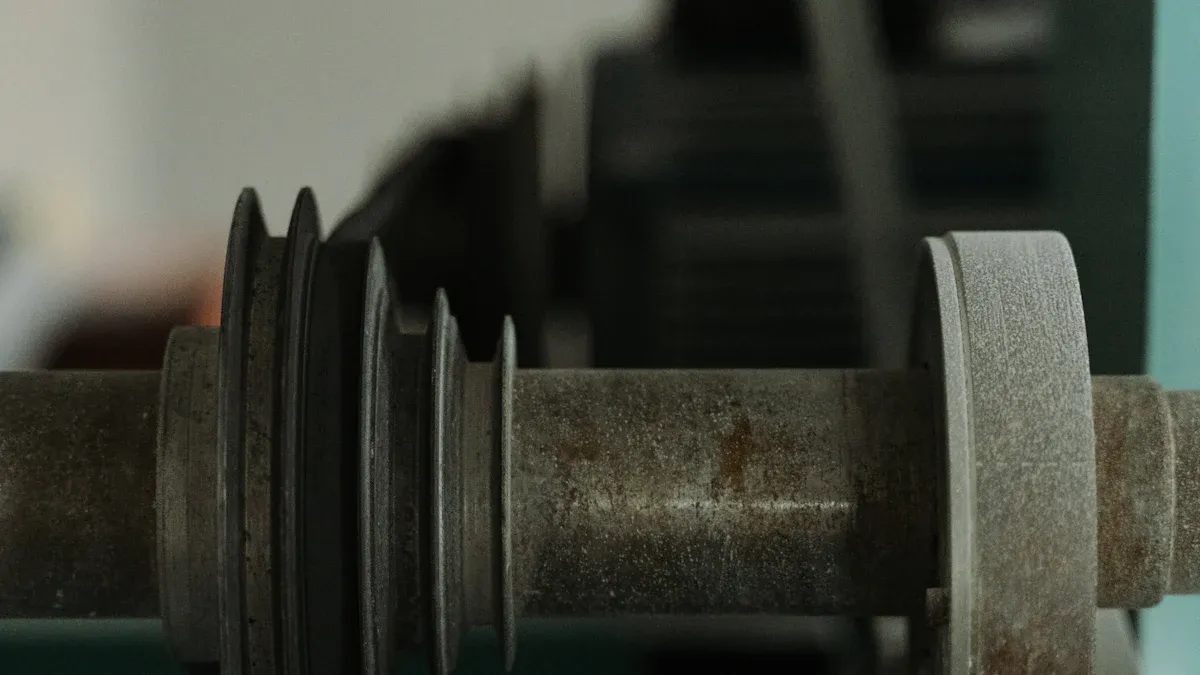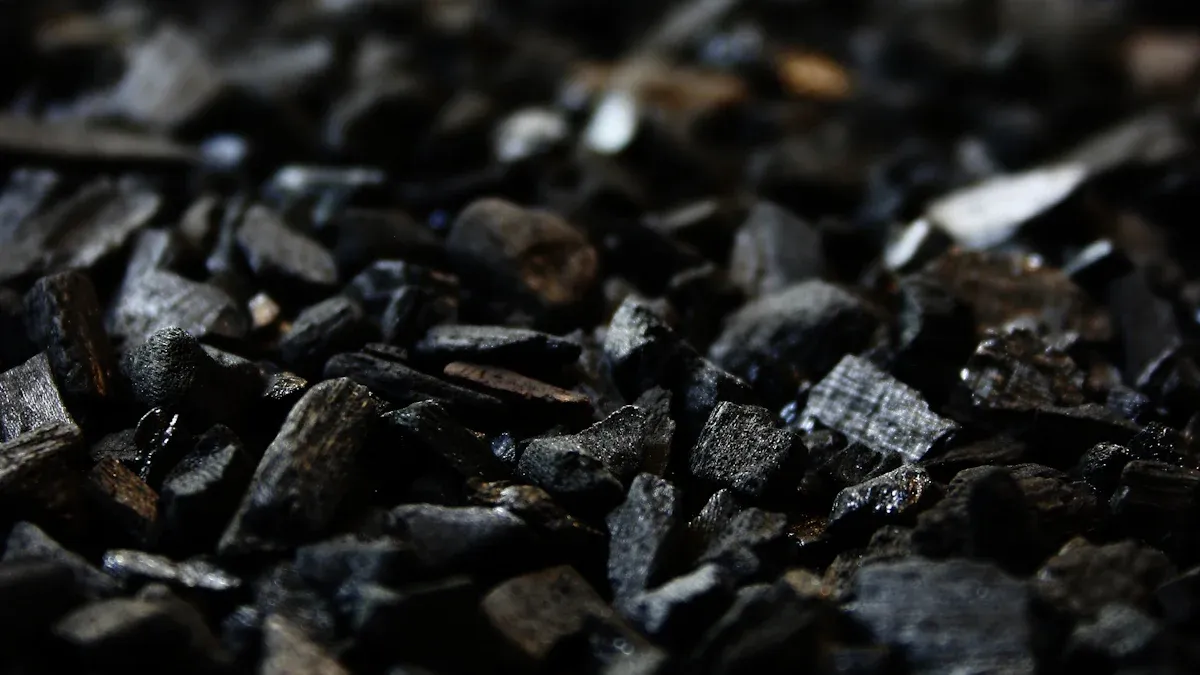
Graphite Susceptors play a vital role in solar panel manufacturing. They ensure precise heat transfer during production, which directly impacts the quality of the panels. Regular maintenance keeps these components functioning efficiently. Neglecting upkeep increases the risk of failures, leading to costly downtime and inconsistent output. You can avoid these issues by prioritizing care.
Key Takeaways
- Taking care of graphite susceptors stops expensive delays and keeps production steady.
- Clean them after every production cycle to stop dirt buildup and keep heat flowing well.
- Check them often to spot damage early, fix it quickly, and make the equipment last longer.
Understanding Graphite Susceptors

What Are Graphite Susceptors?
Graphite susceptors are specialized components made from high-purity graphite. They are designed to absorb and transfer heat efficiently during manufacturing processes. Their unique thermal properties make them ideal for applications requiring precise temperature control. You’ll often find them in industries like solar panel production, where consistent heat distribution is critical.
Role in Solar Panel Manufacturing
In solar panel manufacturing, graphite susceptors play a key role in the production of silicon wafers. These wafers form the foundation of solar panels. The susceptor ensures uniform heating during the crystal growth process, which directly impacts the quality of the final product. Without this component, maintaining the required temperature stability would be nearly impossible.
Tip: Properly functioning graphite susceptors help you achieve higher-quality solar panels with fewer defects.
Why Maintenance Matters
Regular maintenance of graphite susceptors is essential for uninterrupted production. Over time, these components can experience wear, contamination, or thermal damage. Neglecting upkeep can lead to uneven heat transfer, affecting the quality of your solar panels. By inspecting and cleaning them routinely, you extend their lifespan and reduce the risk of costly downtime.
Note: A well-maintained graphite susceptor not only improves efficiency but also saves you money in the long run.
Common Problems with Graphite Susceptors
Wear and Tear
Graphite susceptors face wear and tear during regular use. High temperatures and repeated cycles weaken their structure. Cracks or surface erosion can develop over time. These issues reduce heat transfer efficiency and compromise production quality. You should inspect susceptors frequently to catch early signs of damage. Replacing worn-out components promptly prevents larger problems.
Contamination Issues
Contamination is another common challenge. Dust, debris, or chemical residues can accumulate on the surface of graphite susceptors. These contaminants interfere with heat transfer and lead to uneven heating. Cleaning susceptors regularly with appropriate methods keeps them free from impurities. Avoid using harsh chemicals that might damage the graphite.
Thermal Damage
Excessive heat can cause thermal damage to graphite susceptors. Prolonged exposure to extreme temperatures may lead to warping or structural degradation. This affects their ability to perform efficiently. Monitoring temperature levels during operation helps you prevent overheating. Using susceptors within their recommended temperature range ensures durability.
Handling and Storage Challenges
Improper handling and storage can shorten the lifespan of graphite susceptors. Dropping or mishandling them can cause physical damage. Storing them in humid or dusty environments increases the risk of contamination. Always handle susceptors with care and store them in clean, dry areas. Using protective covers minimizes exposure to harmful elements.
Maintenance Best Practices

Effective Cleaning Methods
Keeping your graphite susceptor clean is essential for maintaining its performance. Over time, contaminants like dust, debris, and chemical residues can accumulate on its surface. These impurities reduce heat transfer efficiency and lead to uneven heating. To clean your susceptor effectively, follow these steps:
- Use a soft, lint-free cloth: Gently wipe the surface to remove loose particles. Avoid abrasive materials that could scratch the graphite.
- Apply a mild cleaning solution: Use a solution specifically designed for graphite components. Harsh chemicals can damage the material, so choose carefully.
- Rinse thoroughly: After cleaning, rinse the susceptor with deionized water to remove any residue.
- Dry completely: Allow the susceptor to air dry in a clean, dust-free environment. Moisture can lead to contamination or corrosion.
Tip: Establish a regular cleaning schedule to prevent buildup and ensure consistent performance.
Inspection and Monitoring Tips
Frequent inspections help you identify potential issues before they escalate. A proactive approach minimizes downtime and extends the lifespan of your graphite susceptor. Here’s how you can monitor its condition effectively:
- Visual Inspection: Look for cracks, chips, or surface erosion. These signs indicate wear and tear that could affect performance.
- Thermal Monitoring: Use infrared thermometers or thermal cameras to check for uneven heat distribution. Hot spots may signal damage or contamination.
- Измерение толщины: Over time, the susceptor may thin due to wear. Use calipers or other tools to measure its thickness and ensure it meets specifications.
Note: Document your findings during each inspection. Keeping detailed records helps you track changes over time and plan maintenance accordingly.
Proper Handling and Storage Guidelines
Improper handling and storage can significantly shorten the lifespan of your graphite susceptor. To avoid unnecessary damage, follow these best practices:
- Handle with care: Always use both hands when lifting or moving the susceptor. Dropping it can cause cracks or fractures.
- Use protective covers: When not in use, cover the susceptor to shield it from dust and debris.
- Store in a controlled environment: Keep the susceptor in a clean, dry area with stable temperature and humidity levels. Avoid exposure to moisture, which can lead to contamination.
- Avoid stacking: Stacking susceptors can cause physical damage. Store them individually on padded surfaces to prevent scratches or dents.
Reminder: Proper handling and storage not only protect your susceptor but also ensure consistent performance during production.
Preventative Maintenance for Graphite Susceptors
Daily Maintenance Tasks
Daily maintenance keeps your graphite susceptor in optimal condition and prevents minor issues from escalating. Start by inspecting the surface for visible signs of wear, such as cracks or erosion. Use a soft cloth to remove dust or debris that may have settled during operation. Check for any contamination that could interfere with heat transfer.
Tip: Perform cleaning tasks at the end of each production cycle. This ensures the susceptor is ready for the next use without delays.
Monitor temperature levels during operation. If you notice uneven heating, investigate immediately. Addressing small problems early prevents larger disruptions.
Weekly and Monthly Inspections
Weekly and monthly inspections provide a deeper look into the condition of your graphite susceptor. Begin by conducting a thorough visual inspection. Look for structural damage, such as chips or thinning areas. Use calipers to measure thickness and confirm it meets specifications.
Create a checklist to track key inspection points:
- Surface integrity
- Contamination levels
- Thickness measurements
- Heat distribution
Use thermal imaging tools to identify hot spots or uneven heat transfer. These tools help you pinpoint areas that may require cleaning or repair. Document your findings to monitor changes over time.
Reminder: Schedule inspections during downtime to avoid disrupting production.
Long-Term Maintenance Planning
Long-term maintenance planning ensures your graphite susceptor remains reliable for years. Develop a maintenance schedule that includes cleaning, inspections, and replacements. Factor in the susceptor’s expected lifespan and usage frequency.
Train your team on proper handling and storage techniques. This reduces the risk of accidental damage. Invest in high-quality cleaning solutions and tools designed for graphite components.
Consider partnering with a supplier for periodic professional inspections. They can provide advanced diagnostics and recommend replacements when necessary.
Note: Long-term planning saves money by reducing unexpected repairs and downtime.
Troubleshooting and Repairs
Identifying Damage Early
Spotting damage early prevents costly repairs and downtime. Regular inspections help you catch issues before they worsen. Look for visible cracks, chips, or thinning areas on the surface of your graphite susceptor. Uneven heat distribution is another warning sign. Use thermal imaging tools to detect hot spots or irregularities. If you notice contamination, clean the susceptor immediately to restore its efficiency.
Tip: Keep a log of inspection results. Tracking changes over time helps you identify patterns and predict potential failures.
Repairing Minor Issues
Minor issues can often be fixed without replacing the entire susceptor. For small cracks or chips, apply a graphite-compatible repair compound. This seals the damage and restores the surface. If contamination is the problem, clean the susceptor using the methods outlined earlier. Addressing minor wear promptly ensures consistent heat transfer and extends the component’s lifespan.
Reminder: Always use tools and materials designed for graphite components. Improper repairs can cause further damage.
When to Replace a Graphite Susceptor
Sometimes, repairs aren’t enough. Replace the susceptor if you notice severe structural damage, such as large cracks or significant thinning. Persistent uneven heating is another indicator that replacement is necessary. Using a damaged susceptor compromises production quality and increases downtime. Consult your supplier for guidance on selecting a replacement that meets your specifications.
Note: Replacing a worn susceptor improves efficiency and reduces long-term costs.
Advantages of Proper Maintenance
Reduced Downtime
Proper maintenance of your graphite susceptor significantly reduces downtime in your production process. When you clean and inspect it regularly, you prevent minor issues from escalating into major failures. This proactive approach ensures your equipment operates smoothly without unexpected interruptions.
Tip: Schedule maintenance during non-production hours to avoid disrupting your workflow.
By minimizing downtime, you maintain consistent production schedules and meet your delivery deadlines. This reliability strengthens your reputation and keeps your operations running efficiently.
Cost Savings
Investing time in maintenance saves you money in the long run. Neglecting upkeep often leads to costly repairs or replacements. For example, a damaged graphite susceptor may require immediate replacement, which can strain your budget. Regular cleaning and inspections help you avoid these expenses by extending the lifespan of your equipment.
Additionally, well-maintained components consume less energy, reducing operational costs. You also save on labor costs by preventing emergency repairs that require additional resources.
Reminder: Maintenance is a cost-effective strategy that protects your bottom line.
Enhanced Efficiency and Quality
A well-maintained graphite susceptor ensures consistent heat transfer, which directly impacts the quality of your solar panels. Uniform heating reduces defects and improves the overall efficiency of your production process. This results in higher-quality products that meet industry standards.
Efficient equipment also boosts productivity. When your susceptor operates at peak performance, you can produce more panels in less time. This increased output enhances your profitability and helps you stay competitive in the market.
Note: High-quality products and efficient operations are the hallmarks of proper maintenance.
Maintaining graphite susceptors ensures optimal performance and consistent production. Regular care reduces downtime and saves costs by preventing expensive repairs. Proactive maintenance also improves efficiency and product quality.
Reminder: Adopt a preventative maintenance schedule today. Small, consistent efforts protect your equipment and keep your solar panel manufacturing process running smoothly.
FAQ
How often should you clean a graphite susceptor?
You should clean it after every production cycle. Regular cleaning prevents contamination and ensures consistent heat transfer during manufacturing.
What tools are best for inspecting graphite susceptors?
Use thermal cameras, calipers, and magnifying glasses. These tools help you detect cracks, thinning, or uneven heat distribution effectively.
Can you repair a severely damaged graphite susceptor?
No, you should replace it. Severe damage compromises performance and affects production quality. Consult your supplier for a suitable replacement.
Tip: Always follow the manufacturer’s guidelines for maintenance and repairs to maximize the lifespan of your graphite susceptor.


